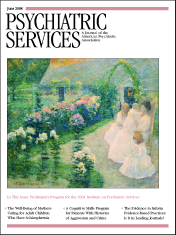The Disease Analogy and Substance Abuse
To the Editor: In the Alcohol & Drug Abuse column in the November 2003 issue, Drs. Marlowe and DeMatteo (1) objected to the use of the disease analogy to conceptualize and treat substance abuse and to formulate drug policy. They made the point that although antisocial behavior is not treated as a disease, the population distribution for it is much the same as it is for substance abuse, hypertension, and diabetes. In elegantly making their point, however, the authors seem to have missed the point.
The literature is clear that all these conditions—substance abuse, antisocial behavior, hypertension, and diabetes—have their roots in genetic vulnerability and that their behavioral expression is shaped physiologically by environmental influences and personal choices (2,3,4). Labeling these conditions diseases is not a form of forgiveness or a reprieve from responsibility. No one would contend that personal choices don't affect the course of both diabetes and bipolar illness. No one would deny that treatment adherence may not fully control an inexorable course in either condition (5). But what we do deny is that the substantial difference between what we call social disorders and what we call diseases is our lack of knowledge of when and how to effectively intervene in those so-called social disorders. And what we also deny is that the search for that knowledge has been severely impeded by false distinctions between physical and mental and between social and medical disorders.
Setting up false dichotomies does not protect us from poorly conceived policy. Drs. Marlowe and DeMatteo—and policy makers—would be better served by using the old child psychiatry model—"vulnerability, risk, adaptation"—to understand how and whether the policies they envision do, in fact, apply and will or will not work.
Dr. Scott was formerly vice-president of medical services at Prudential Group Life and Disability and currently serves as a consultant to the City of Boston.
1. Marlowe DB, DeMatteo DS: Drug policy by analogy: well, it's like this…Psychiatric Services 54:1455–1456, 2003Google Scholar
2. Jacobson KC, Prescott CA, Kendler KS: Sex differences in the genetic and environmental influences on the development of antisocial behavior. Development and Psychopathology 91:395–416, 2002Google Scholar
3. Nestler EJ, Aghajanian GK: Molecular and cellular basis of addiction. Science 278:58–53, 1997Crossref, Medline, Google Scholar
4. Rutter M: Nature, nurture, and development: from evangelism through science toward policy and practice. Child Development 73:1–21, 2002Crossref, Medline, Google Scholar
5. Gabbard GO: Antisocial personality disorder: when is it treatable? Psychiatric Times, Jan 2, 2004, p 25Google Scholar



